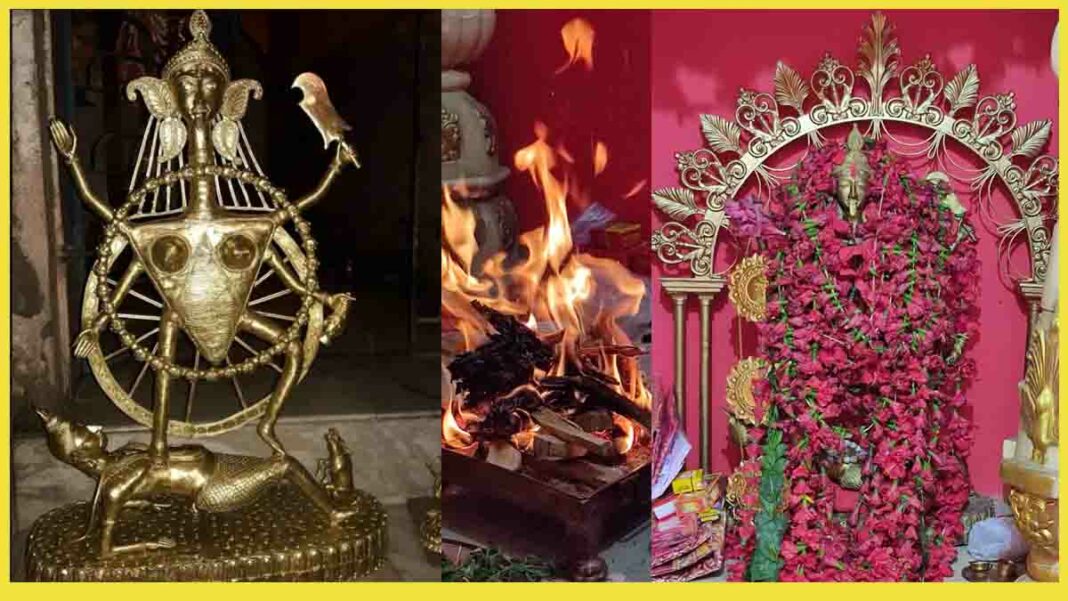Dokra Kali in Kolkata is the only idol in the world, where Goddess Kali is worshipped in this ancient tribal art form. Dokra is a traditional craft that uses lost-wax casting, commonly called “Cire Perdue,” to cast non-ferrous metals. It is the oldest non-ferrous metal casting technique that humankind is aware of.
The rudimentary method dates back to the Indus Valley Civilization. Because of its primitive simplicity and astonishingly detailed designs, Dokra’s artistry is widely regarded worldwide. The figures are even more appealing because of their rustic and antique polish. The popularity of dokra art has grown recently and is now exported to countries worldwide.
Parts of West Bengal, Odisha, Chhatisgarh, and Andhra Pradesh are home to dokra, a distinctive and ancient art style.
History of Dokra Art
The history dates back to the Indus Valley Civilization, where the famous “Dancing Girl’ statue is considered the first of this tribal art form. Another interesting story dates to 3000 years ago when the King of Bastar (now in Chattisgarh) was gifted a Dokra necklace by a craftsman for the Queen. The skill so impressed the King that he gave the craftsman the title of “Ghadwa”, which “Ghadwa” is a derivative of “Ghana,” which means to melt and work with wax. This vibrant ancient art form is now almost extinct and can be found in a few villages of West Bengal, Jharkhand, Orissa, Chattisgarh, and Telangana.
The Making Process of Dokra
Making a Dokra item is an elaborate process and requires much precision and concentration on the part of the crafter. The process involves several steps:
Step 1: The artist first makes a clay core modelled in the shape of the craft he desires to make.
Step 2: The clay core is then covered with a layer of tar, resin, wood gum, or nut oil. Intricate motifs are moulded and carved into the exterior wax layer. This step necessitates the crafter’s full attention, and the quality of the product increases with finer designs.
Step 3: To create a mould or cast, clay is spread over the wax layer covering the spaces between the detailed engravings.
Next, a hole is formed in the mould so liquid metal or alloy can be poured through it. Drain ducts are left for the wax that melts when the clay is baked.
Step 4: As the liquid metal or alloy is poured into the mould, it hardens between the interior surface and the mould’s core, eventually forming Dokra figurines. Additionally, only one product is produced using a single mould.
Step 5: The item is then gradually heated over a fire. The wax melts under heat, and the molten metal alloy fills the finer gaps created by the melting wax. Hot earth must be used to seal the hole that was created.
Step 6: The liquid metal poured in solidifies between the mould’s interior surface and core. The thing is then allowed to cool. The exterior clay layer is chipped off when the artefact has cooled to reveal its final shape. The figurine also has any excess metal parts removed.
Step 7: After that, the metal figurine is polished and given a glossy finish. Because a cast can only be used once per figure, this method is distinctive. It can take several months to complete one product due to the process’s length, and the artefact’s complexity determines how much time is needed.
Dokra Kali Idol & Worship
In 2017, this form of the Goddess Kali came in the dreams of a Kolkata-based artist consecutively for three days. He then realised that this might indicate he started worshipping the Goddess, and he sketched the form exactly as the Goddess appeared in his dream. Then he went to the Dokra village, Biknah, in Bankura, West Bengal district.
Normally, a single figurine takes several weeks to be created, but astonishingly, when the craftsmen started working on the figure, there was no interruption in work due to rain (which usually happens specifically during the months of September-October) and the form of Ma Dokra Kali was completed in 3 weeks.
The 3-feet metal alloy figure was then brought to Kolkata and worshipped on the auspicious day of Kali Puja in 2017. Since then, the puja has gained immense popularity, and every year, hundreds of people flock to the temple to pay their homage to the Goddess. The Dokra Temple Trust Committee members also organise social welfare campaigns like blood donation camps, eye-checkup camps, health-checkup camps, and so on. The Dokra Kali Mata Temple now acts as a platform where people from all religions, castes, and creeds come together and spend a happy time with each other, acting for a social and noble cause.
Dokra Artisans and their present economic situation
For generations, the Dokra artisans in different parts of India struggled for their livelihood. Many of them turned to other professions, and presently the art is restricted to a handful of families in a few villages scattered in a few states of India. This cultural heritage of India was becoming a dying legacy.
However, with the government’s effort and a few non-profitable organisations, these artisans are getting their due recognition nowadays. The state governments are helping them to sell their artefacts directly without the intervention of middlemen. With the initiation of Dokra Kali Puja, more number of people are becoming aware of this nearly extinct heritage art of India. Slowly, the artisans are seeing a new ray of economic upliftment. Now, the next generations are also becoming interested in coming back to their ancestral profession, thus keeping the torch of cultural heritage burning.
Also Read: Pranic Healing – Meaning, Method, Benefits Everything You Need To Know



